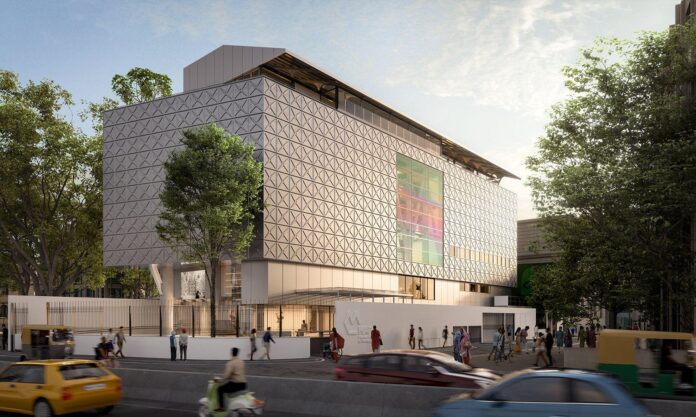The Museum of Art and Photography in Bengaluru (formerly Bangalore), south India’s first major private art museum, will open to the public in December after a pandemic-induced delay. The institution will attempt to fill a gap in a country where many museums are in a “state of dilapidation”, according to India Today.
The new museum, based in the country’s burgeoning “silicon valley”, is
housed in a 44,000 sq. ft building designed by the Bengaluru-based
architects Mathew & Ghosh. Its ambitious exhibition programme
includes Visible/Invisible which explores the representation of women in
art history from the Indian subcontinent. K G Subramanyan’s painting Woman in the Blue Room, (1981) and Mrinalini Mukherjee’s hemp sculpture Naag (1986) are among the works included.
The US artist Chitra Ganesh will show a photographic series called
Hidden Trails (2007). “My installation, photography and sculptural work
is inspired in particular by mythological narratives, present day
imperialism and queer politics, old Bollywood images and songs, lyric
poetry, and erased moments in South Asian history,” she says in a
previous online statement.
MAP Bengaluru will host the first retrospective of photography by Jyoti Bhatt
Another show, Time and Time Again, is the first major retrospective of
the photography of the Indian artist, Jyoti Bhatt. Curators will draw
from MAP’s photographic archives, containing 1,000 prints by Bhatt and
60,000 negatives. Another exhibition will be dedicated to the artist L N
Tallur, who was born in the State of Karnataka.
The philanthropist and businessman Abhishek Poddar has donated the
bulk of his collection to form most of the MAP’s 60,000 works of art
and artefacts that tell the story of Indian culture stretching from the
12th century to today. It contains sections on photography, folk art,
textiles and design as well as contemporary and 20th-century art,
including works by major South Asian Modernists such as Tyeb Mehta.
Poddar says in a statement: “I believe we need MAP Museum of Art &
Photography now because South Asian cultures represent the cultures of nearly a quarter of the world’s population and yet their stories have not been told.”
At a recent press briefing, Poddar says that the new institution will “push the needle” for museums in India where the budget for culture was cut last year by 15% to INR 26.8bn (£284m). Poddar’s LinkedIn page describes him as the “director of Sua Explosives & Accessories and the managing director of Matheson Bosanquet, an 80-year-old company with activities in tea production, trading and export”.
The land for the museum was purchased through a donation by the
Poddar Family; the building is funded partly by a donation from the
Poddar family and group of philanthropists including Kiran Mazumdar
Shaw and Sunil Munjal along with companies such as Citi and Tata.
“MAP is a not-for-profit institution that currently receives no government
funding and is a unit and major project of the Art & Photography
Foundation. The programming is funded through private patrons and
corporate sponsorship. Any revenue collected through retail,
membership or ticketing for entrance fees, special exhibitions, and
certain events will be reinvested back to underwriting the museum’s
activities,” a spokesperson says.
So is this a breakthrough moment for Indian museums? Indian-born
Natasha Ginwala, an associate curator-at-large at the Gropius Bau in Berlin, says: “What is exceptionally interesting about MAP is the complex web of visual cultures that meet in this collection ranging from early
photography to ‘calendar art’, cinema posters, and indigenous traditions
from metalwork to painting. These facets are accompanied by an
expansive inclusion of figures from modernism who emerged across the
country, the likes of Jyoti Bhatt to Arpita Singh. What remains to be seen
is how adventurous the curatorial and discursive framework will be
across the exhibitions and programmes produced.”
In recent years, private museums and foundations are playing a more
active role in India’s cultural landscape which is a vital and welcome
sign, she adds. “[This development] needs to be understood in light of the social fractures, limited freedoms, and ethnonationalism in today’s
politics. These entities have a huge responsibility to ensure access and an atmosphere of openness while safeguarding the pluralism of historical
and contemporary cultural experience.”
Last year, MAP museum curators used artificial intelligence software
to create a “conversational digital persona” of the late Bombay
Progressive painter, M F Husain. Throughout the pandemic, MAP developed a number of innovative digital initiatives including Museums Without Borders (each episode in the YouTube series juxtaposes a work from MAP with an object from a partner museum). “We hope MAP will be a catalyst that will help democratise art. We hope to collaborate with other museums across the country to create exciting spaces that people enjoy visiting,” MAP’s director Kamini Sawhney says.

























